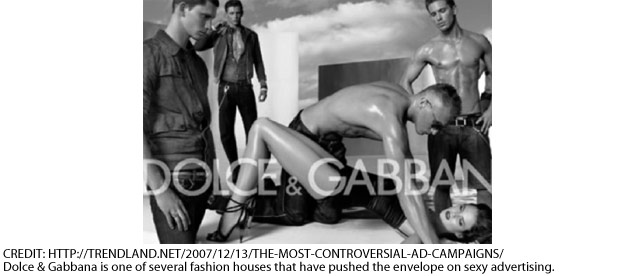The rumours are true: Sex sells

Calvin Klein underwear is sexy. Dolce & Gabbana anything is sexy. But Prada? Not so much. Please don't misunderstand; I'm loving and coveting Ms. Miuccia's plaids and python prints as much as any other Prada fan this season, but the Italian design house doesn't ooze the same sex appeal that made Dolce & Gabbana's leather and leopard print collections iconic and famously sexy. It's not just the fine tailoring and vampy lacquered lips that create a sense of sexiness for Dolce & Gabbana (although that certainly contributes to it), but, as my friend Julie (who is currently living and working in Manhattan in an advertising agency) so clearly deduces, it's mostly their ads.
Dolce & Gabbana have gotten almost as much attention for their racy ads as they have for their designs. Famous for using scantily clad models of both sexes in rather suggestive poses, some say the design house took it one step too far and created a bit of a controversy in 2007 with an ad that depicted what many called a rape scene. While one male model pins down a female model, four other male models stand nearby (in various states of undress) looking as if they are waiting to have their turn. Dolce & Gabbana defended their choice by making clear their point was to create a vision of fantasy, not rape. Despite this stir, the brand continues to shoot sexy ad campaigns; currently, the fall 2011 set features decidedly more fully dressed models, yet still evokes a sense of sexiness as the models are casually draped and lounging on one another.
Perhaps the originator of saucy ads, Calvin Klein has been doing both print and film ads in a sexy way since the '80s. Three decades ago, when using sex to sell was a little less commonplace, Klein was harshly accused of promoting child pornography for using young models to say and do provocative things. Most notably, in 1995, the brand used models reportedly as young as 15 in an ad campaign meant to imitate pornographic "picture sets" from the '60s and featured TV ads of the youngsters undressing with the encouragement of a male voice. Pulling the ads from print and broadcast skyrocketed the brand's sales. A marketing director claimed this took the brand's "coolness factor from a 10 to a 60." Not deterred by the nasty accusations, Klein launched another ad campaign in 1999 for his children's underwear line that included two separate sets of pictures, both featuring two small children of the same sex holding hands and jumping on a sofa. Uninterested in the innocent "child's play" intentions, critics jumped at the chance to indict the designer with child pornography usage again for printing pictures of children in their underwear.
Calvin Klein and Dolce & Gabbana are far from the only brands using risqu� ads to sell their products. Recently, an Edmontonbased hair salon made headlines nationwide for printing an ad with a woman, who admittedly had gorgeous hair, sitting on a couch looking rather stiff while a man posed behind her, looking rather stern. The tagline read, "Look good in all you do." The kicker was that the woman had a serious shiner and the ad clearly implied that the salon can make even domestic violence glamorous. Sexist ads (much like the opined Dolce & Gabbana rape ad) have taken sexy ads one step further. With products from perfume to burgers (remember Paris Hilton devouring a Carl's Jr. burger in a bikini?) to bathtubs using seductive ads to sell their goods, there's not much left to the imagination.













